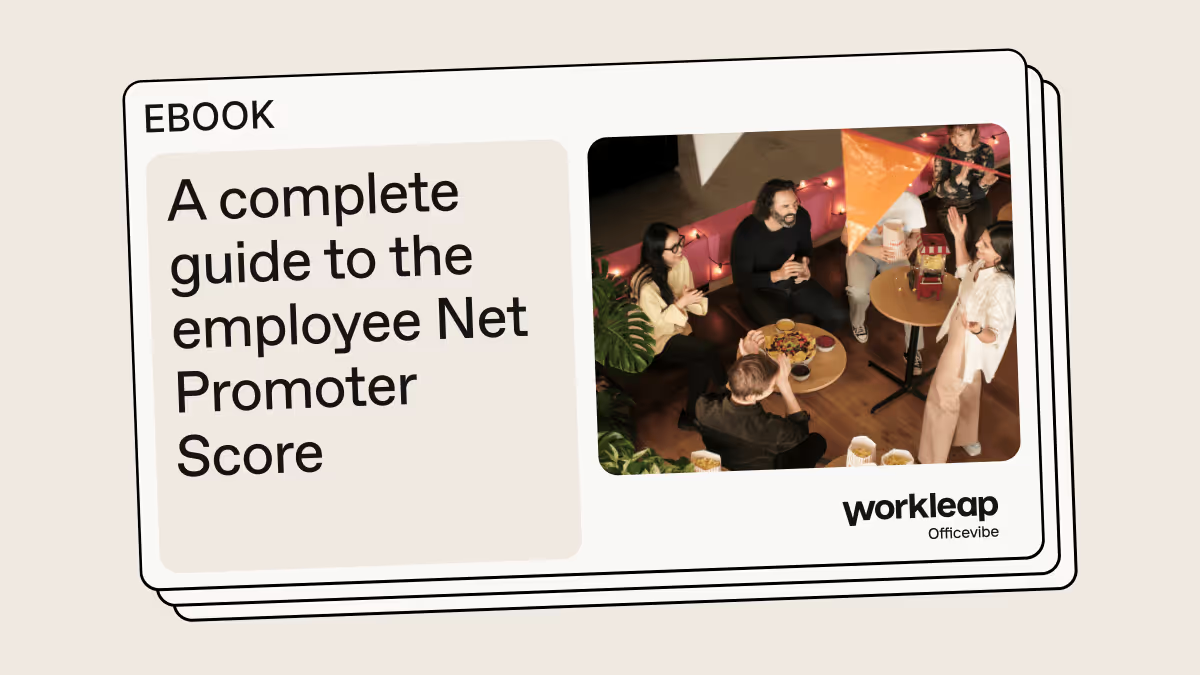20 employee Net Promoter Score (eNPS) questions for your organization

Discover Workleap Officevibe's benchmark report on 12 key employee engagement metrics

Businesses have traditionally crafted their surveys from a customer standpoint, with questions on customer satisfaction, how to acquire new customers, and on ways to boost customer loyalty. But today, business leaders across industries understand that employee satisfaction is just as vital to the operation of the organization.
Just as a customer NPS (Net Promoter Score) can help companies map out the customer journey and identify unhappy customers, the employee Net Promoter Score (eNPS) helps organizations gauge employee experience and get actionable feedback to improve employee engagement, satisfaction, and loyalty.
What is an eNPS survey, and how can businesses use online surveys to build a healthier company culture? Read on as we share some helpful insights and provide employee Net Promoter Score questions you can use in your next survey.
What is an eNPS survey?
Fred Reichheld of Bain & Company* created the net promoter system in 2003. He discovered that using an NPS survey to calculate a company's promoter percentage helps organizations develop more effective marketing strategies and improve both brand recognition and brand loyalty.
Since 2003, many companies have implemented NPS in their market research. More recently, workplace culture-oriented organizations have begun applying this method to their employees as well as their customers.
* Net Promoter Score and NPS-related emoticons are Bain & Company's registered trademarks.
Employee NPS and employee engagement
Employee NPS is a metric that helps you know how employees feel about your organization and whether they would recommend it as a good place to work. ENPS works very much like customer NPS but treats employees as the customers and your organization as the product package you're trying to "sell" to top talent in your industry.
The eNPS formula has a tight relationship with employee engagement, which impacts just about every aspect of your business, from employee retention to long-term success. Engaged employees are more productive, more creative, and likelier to remain in the company.
Measuring eNPS: How to calculate employee net promoter scores
How do you measure employee loyalty, engagement, and satisfaction? It may seem extremely complicated, but in fact, employee net promoter score surveys use a simple eNPS formula.
The eNPS score revolves around the following question: "On a scale of 0 to 10, how likely are you to recommend our company as a workplace?"
The respondents fall into three categories:
- Promoters: Employees who rated your company at 9 or 10
- Neutrals: Employees who gave your organization a rating of 7 or 8
- Detractors: Employees with ratings of 0 to 6
Promoters' feedback marks the happiest, most loyal employees who are likeliest to recommend your company to others. Detractors are dissatisfied employees who are unlikely to promote your organization and may also leave their position if a different work opportunity crops up.
This is how you calculate employee net promoter scores:
{emphasize}
eNPS = Percentage of promoters - percentage of detractors
{emphasize}
For example, if your organization has 100 employees on its roster, 25 of whom are promoters, 10 are detractors, and the rest are neutrals, your employee net promoter score (eNPS) equals 25 - 10 = +15.
What constitutes a good eNPS score? Anything above +10 shows that your company has a healthy percentage of generally satisfied employees. Leading companies that invest quite a few resources in keeping their employees happy often boast an eNPS score of 40 or higher. HubSpot, which is well-known for its investment in employee loyalty and satisfaction, has an eNPS score of 77.
You should track your employee net promoter score over time and always aim for a higher eNPS. However, the eNPS score as a standalone metric isn't enough to evaluate employee satisfaction and engagement. Longer and more detailed employee engagement surveys will help you separate happy but passive employees from engaged and active team members that drive company success.
20 examples of employee Net Promoter Score questions
The primary employee Net Promoter Score question is always some variation of, "On a 0 to 10 scale, how likely are you to recommend our organization as a workplace to a friend or colleague?"
For more useful and detailed employee feedback, you should also include at least one follow-up question in your survey. We list 20 survey questions below that typically yield useful results in eNPS and employee engagement surveys.
1. Please share the primary reason for your score.
What made this employee rank your company at 10, 7, or zero? Does it have to do with workload, salary, or other factors?
2. What would prompt you to give our company a higher score?
Would your employees value more flexible hours, more helpful management, or a broader healthcare package?
3. What do you enjoy most about working in this company?
Discover what your employees value most about your organization. Is it the opportunity for professional advancement, a positive company culture, or perks like a free lunch program?
4. Is there any specific factor that would prevent you from recommending our company to potential employees?
While this question may yield some potentially uncomfortable answers, like "low salary" or "toxic managers," you can use it as a springboard for improvement.
5. Would you say that your experience of working at our company has improved or worsened over the past 6 months?
Employee Net Promoter Score and employee engagement are all about trends. Even if the current situation could use improvement, this question can help you discover whether your organization is on the right track.
6. Would you say our company invests enough resources in employee satisfaction and well-being? Yes/no.
This type of question can give you easily quantifiable results ("60% of our employees believe that this organization should invest more in employee well-being").
7. On a scale of 0 to 10, how helpful is your manager when you encounter a problem at work?
A high percentage of low ratings here, coupled with a generally low eNPS score, could point to a management-level problem affecting employee engagement that you may wish to discuss with your team leaders.
8. Do you see yourself working in this organization for the next five years?
You may structure this as a yes/no question or offer a more open format by adding, "Why or why not?" Either way, you may gain helpful insights into the risks of employee attrition in your company.
9. On a scale of 0 to 10, how recognized and valued do you feel in our organization?
Employee recognition is a major driver of employee engagement, satisfaction, and loyalty. Low scores in this area may indicate that your organization needs more recognition initiatives.
{emphasize}
💡Check out these 8 tips to increase recognition in the workplace!
{emphasize}
10. How exciting or interesting would you say your work is, on a scale of 0 to 10?
Employees who give your organization an overall high score but rank low in this question may be laid-back team members who will do their job yet are unlikely to go the extra mile.
11. Would you say our organization is more or less attractive to employees than its industry competitors? (More, less, the same)
Do many of your employees believe that other companies in your industry offer their employees a better deal? Consider looking into your competitors' employee engagement practices.
12. Did recent changes in our organization improve, impair, or have no effect on your work experience?
This question may be useful if your company has recently undergone major changes like restructuring or increased automation.
13. What would potentially induce you to move to a different organization?
Is it a higher salary, an expanded benefits package, or a company-sponsored vacation in Hawaii? Knowing the answer can help you circumvent your competitors.
14. What is your biggest challenge/difficulty in working here?
This question gives your employees an opportunity to voice their concerns: from lack of training to inefficient software.
15. Why did you choose to work with us?
Answers like "the chance of professional growth" or "a competitive salary" can let you know what attracts employees to your organization.
16. From 0 to 10, how closely would you say our organization met the expectations you had when you started working here?
This follows up on the previous question: for example if a worker stated "flexible hours" was their main attraction to your company but gave a score of 3 here, you may wish to look into employee schedules.
17. Which of the following, in your opinion, should we prioritize to improve? a) work-life balance, b) employee incentives, c) workplace culture.
Close-ended questions of this type help you focus on relevant answers and achieve measurable data.
18. For promoters: What makes our organization a good choice for employees?
This question focuses on your organization's top players and aims to find out what makes them happy about working with you.
19. For detractors: What is your biggest obstacle to achieving a positive work experience in our organization?
Show your least satisfied employees that you validate their experience by asking a question that focuses on their needs.
20. For neutrals: How can we take your work experience from ordinary to great?
Find out what steps you can take to turn disengaged workers into enthusiastic, driven team players.
Types of questions in eNPS surveys
As you see from the examples above, your employee Net Promoter Score survey questions may fall under the following categories:
{emphasize}
- Digital scale questions ask the respondents to rate their experience or the strength of their agreement with a particular statement on a 0 to 10 scale. The survey's first and most essential question belongs to this type. Digital scale questions are convenient because they yield easily measurable results.
- Open-ended questions. While an open-ended question gives harder results to group or calculate, it also allows participants to offer personalized, detailed feedback that provides valuable insights. An open-ended question is, "What, in your opinion, is the most important step the company management could take to improve your job satisfaction?"
- Yes/no questions. Despite their rigidity, yes/no questions produce focused, quantifiable results that can help you evaluate employee experience. Questions like, "Are you happy with our transition to new CRM software?" work well in a yes/no format.
{emphasize}
Employee Net Promoter Score survey structure
Every employee Net Promoter Score poll starts with the core question: asking your employees to rate their workplace on a 0 to 10 scale. It proceeds with at least one follow-up question that encourages the employee to elaborate on their first answer and can help you glean useful information about that employee's experience in your company.
To get the most accurate and useful survey results, we suggest that you:
{emphasize}
- Send out eNPS surveys once a quarter. Quarterly surveys will regularly assess your employee Net Promoter Score without over-surveying.
- Keep the survey brief. A classic eNPS survey consists of just two questions: the 1 to 10 scale rating and another question that gives insight into the respondent's first answer. You may include a few additional questions, but keep the survey short to avoid survey fatigue.
- Ensure anonymity. Some employees feel uncomfortable giving negative or constructive feedback if they believe the management can identify them. To encourage unbiased answers, assure your team that all responses will remain anonymous.
- Encourage honesty. We all like a pat on the back, but that's hardly the purpose of your survey. You want the results to reflect reality as closely as possible, just as if you were doing market research. You may include a statement like, "We value your honest opinions. Please let us know what you really think, even if it means giving a low score."
- Motivate participants. It's easy to forget about answering a survey in the middle of a busy workday. To encourage higher participation rates, you can give your staff a nudge via email or your company's work operating system and say something like, "We hope you'll take the time to answer our recent survey. Your feedback helps us consistently work towards making our company a better place." A targeted, easy-to-use survey platform like Officevibe will help promote survey participation.
{emphasize}
Officevibe: The people-first platform for helpful employee feedback
Happy employees are the key to your company's success. Officevibe's people-friendly, employee engagement solution will help you measure engagement, gain actionable insights to improve employee satisfaction and work towards continuous improvement in your company's culture.
Check out more articles by Workleap to dive deeper into how employee surveys work and how they can help promote your organization's values.
Give HR and managers the clarity, confidence, and connection to lead better every day.


%20(1).avif)


.avif)
.avif)








